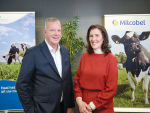WE ARE rapidly approaching the final quarter of a season many Australian dairy farmers will want to forget.
The combination of a drought-induced grain price spike and lower farmgate milk prices has savaged margins, while Mother Nature has done little to extend a helping hand. On a more positive note, dairy commodity prices have trended upwards in recent weeks on the back of a broader slowdown in supply, as climatic challenges combine with difficult production economics in key global exporting regions.
That’s a promising sign for 2013-14 opening prices, however for the remainder of 2012-13 – with most of this season’s manufactured production already sold and prices locked in – a key driver of final farmgate returns will be the exchange rate at which contracted commodity prices in US dollars are remitted to Australian-based exporters in Australian dollars.
International dairy trade is carried out in US dollars – as is the case for many commodities. As anybody involved in an export industry is well aware, the US dollar (USD) value of the Australian dollar (AUD) is very high in historical terms, having spent most of the past two years above parity. A higher AUD means exporters must pay more of their USD sales earnings to purchase Australian currency to bring back to Australia, leaving less available for meeting operating expenses (including raw milk purchases) and retaining profits.
To quantify the impact, Dairy Australia modelling suggests that at current commodity prices, a reduction of US$0.05 in the value of one Australian dollar would mean a potential A$0.32/kgMS or 2.4c/L increase in farmgate pricing for a ‘typical’ export manufacturer. Take the exchange rate down US$0.20 and the price differential is more like A$1.50/kgMS or 11c/L. Short term changes would naturally be filtered by a variety of other factors – not least of all each processor’s exchange rate hedging position, but suffice to say the effect is significant.
The AUD has been kept high relative to the USD for much of the past decade by the mining boom, as elevated mineral commodity prices and strong purchasing by China and other major trading partners drive demand for Australian currency. More recently, despite falls in commodity prices and interest rates, the AUD remains at high levels due to its status as a ‘safe haven’ currency – a low risk asset for the RBA’s international equivalents and sovereign wealth funds to invest in as economies such as the US, Japan and Europe experience recession or a slow and shaky recovery. Currency devaluation efforts by some countries such as the US and Japan are weakening their own currencies relative to others – including the AUD.
Whilst the above factors are causing pain for Australian exporters, our New Zealand counterparts face a similar problem. Figure 1 (below) plots an index of the USD against the currencies of other four biggest dairy exporters, with the index based at January 2010. Higher values indicate a relatively weaker currency, while lower values a relatively stronger currency. The chart clearly shows that the Kiwis (whose currency has also seen significant inflows from overseas central banks) are at a similar competitive disadvantage, whilst the Europeans and Argentineans – with economic problems aplenty – are relatively well placed to sell USD priced commodities.
The advantages of a relatively stable economy and strong currency should not be downplayed however. A stable economy means credit is more freely available and domestic demand remains strong, while a strong currency reduces pricing pressures on imported inputs such as fertiliser, machinery and milking plant.
Currency analysts remain divided over the path the AUD is likely to take for the remainder of this season, with a Bloomberg survey of 46 financial institutions producing an AUD range of US$0.90-1.10 by July. Whilst this is a broad range, a growing number of analysts favour a depreciation of the AUD over 2013, based on expectations of a strengthening US recovery, lower iron ore prices and further interest rate cuts by the RBA.
Needless to say, such an outcome could provide a welcome boost to incomes and a helpful springboard to season 2013-14.
• John Droppert is industry analyst with Dairy Australia.


















